Elimination of Critical Use Exemptions for methyl ... - PAN Europe
Elimination of Critical Use Exemptions for methyl ... - PAN Europe
Elimination of Critical Use Exemptions for methyl ... - PAN Europe
You also want an ePaper? Increase the reach of your titles
YUMPU automatically turns print PDFs into web optimized ePapers that Google loves.
To: Minister <strong>of</strong> Agriculture,Minister <strong>of</strong> EnvironmentCC: National ozone <strong>of</strong>fice<strong>PAN</strong> <strong>Europe</strong>Pesticides Action Network <strong>Europe</strong>Development House56-64 Leonard StreetLondon EC2A 4JXUnited KingdomTel +44 (0) 207 065 0920Fax +44 (0) 207 065 0907Email : s<strong>of</strong>ia-paneurope@pan-uk.orgWebsite: www.pan-europe.infoDecember 2005Subject: <strong>Elimination</strong> <strong>of</strong> “<strong>Critical</strong> <strong>Use</strong> <strong>Exemptions</strong>” <strong>for</strong> <strong>methyl</strong> bromideDear XXXWe are very concerned about the large quantities <strong>of</strong> <strong>methyl</strong> bromide permitted <strong>for</strong> so-called“<strong>Critical</strong> <strong>Use</strong> <strong>Exemptions</strong>” in 2005, as reported in the Commission Decision 2005/625/EC (August2005, Official Journal L 219, 47-53). As an ozone-damaging chemical, <strong>methyl</strong> bromide has asubstantial negative effect on the ozone layer, and thereby has negative effects on human healthand the environment. In addition, <strong>methyl</strong> bromide is a highly toxic pesticide, and pesticide workerswho use <strong>methyl</strong> bromide have an increased incidence <strong>of</strong> prostate cancer 1 . Methyl bromide gasposes a significant health risk to agricultural workers and people in nearby communities when itdrifts from fields, or is released in large quantities after treating flour mills or food factories.Under the Montreal Protocol and EC Regulation 2037/2000, <strong>methyl</strong> bromide was scheduled to bephased out by 31 December 2004 <strong>for</strong> all uses except quarantine and pre-shipment. However,Commission Decision 2005/625/EC paragraph (3) says that the Commission received proposals<strong>for</strong> <strong>Critical</strong> <strong>Use</strong> exemptions from several national authorities in <strong>Europe</strong>. <strong>Exemptions</strong> were granted(in some cases at a slightly lower level) as listed in Annex I <strong>of</strong> the Decision.Technically and economically feasible alternatives are available <strong>for</strong> nearly all cases, apart fromcertain special situations <strong>for</strong> which alternatives are genuinely not available, that would amount toless than about 100 tonnes in total in the EU. In the vast majority <strong>of</strong> cases there is no legal basis<strong>for</strong> granting exemptions, as the following points demonstrate:1. EC Regulation 2037/2000 Article 3, 2(ii) provides the basis <strong>for</strong> granting anyexemptions. It states that <strong>methyl</strong> bromide <strong>for</strong> critical use exemptions “shall be allowedonly if no adequate alternatives” are available from any <strong>of</strong> the Parties (Parties refers toany countries that are members <strong>of</strong> the Montreal Protocol, about 150 countries).Methyl bromide is merely one <strong>of</strong> many methods <strong>for</strong> controlling pests such as nematodesand fungi in soil, and insects in flour mills. Alternatives are widely used in all countries <strong>of</strong><strong>Europe</strong>, including our own countries and others that requested <strong>Critical</strong> <strong>Use</strong>s. Examples <strong>of</strong>1 MBTOC (1995) “Report <strong>of</strong> the Methyl Bromide Technical Options Committee <strong>for</strong> the 1995 Assessment – Review<strong>of</strong> alternatives to <strong>methyl</strong> bromide”; Alavanja et al. (2003) “<strong>Use</strong> <strong>of</strong> Agricultural Pesticides and Prostate Cancer Riskin the Agricultural Health Study Cohort”, American Journal pf Epidemiology, Vol. 157, No 9.<strong>PAN</strong> <strong>Europe</strong> is facilitated by <strong>PAN</strong> Germany and <strong>PAN</strong> UK<strong>PAN</strong> <strong>Europe</strong> is a UK Not-<strong>for</strong>-Pr<strong>of</strong>it Private Limited Company, No. 4750630
available alternatives can be found in case studies published by UNEP, MBTOC andothers 2 and can also be found in a <strong>Europe</strong>an database <strong>of</strong> available alternatives (onwebsite <strong>of</strong> Ozone Secretariat, compiled as a requirement <strong>of</strong> Decision Ex.I/4 <strong>of</strong> theMontreal Protocol 3 ).Since adequate alternatives are available in our own region and from many Parties, thereis no legal basis <strong>for</strong> granting exemptions.2. The Montreal Protocol Decision IX/6 and Regulation 2037/2000 Article 3, 2(ii) listsseveral criteria that have to be met be<strong>for</strong>e any exemptions can be granted. The firstcriteria in Decision IX/6 is that “significant market disruption” must be determinedbe<strong>for</strong>e any use <strong>of</strong> <strong>methyl</strong> bromide can qualify <strong>for</strong> exemptions. Since alternatives canprovide crop yields similar to MB in the vast majority <strong>of</strong> cases, the market <strong>for</strong> these cropscannot be disrupted. Even if MB users claim that crop yields would be reduced slightly,this would not be greater than the fluctuations that occur in any crop from year to year(due to diverse reasons). Moreover, the market <strong>for</strong> crops such as strawberry, melon,tomato and other vegetables is very large today because it’s a <strong>Europe</strong>an market –suppliers can source products from any country they wish in the EU, also Africa, Eastern<strong>Europe</strong> and further afield. It is there<strong>for</strong>e impossible <strong>for</strong> “significant market disruption” tooccur when <strong>methyl</strong> bromide is phased out.We would be grateful to receive a description <strong>of</strong> the procedures and steps that the EnvironmentMinistry and Agriculture Ministry intend to take to eliminate all <strong>methyl</strong> bromide exemptions by theend <strong>of</strong> 2005 [or within six months]. We would also like to know if the Environment or AgricultureMinistry plans to request <strong>Critical</strong> <strong>Use</strong> exemptions <strong>for</strong> 2006 or 2007? If so, we respectfully requesta list <strong>of</strong> the specific uses and pest species.We note that some countries made significant ef<strong>for</strong>ts to reduce <strong>methyl</strong> bromide and eliminated itwell be<strong>for</strong>e the international phase-out date <strong>of</strong> 2005. The Netherlands, <strong>for</strong> example, was thelargest user <strong>of</strong> <strong>methyl</strong> bromide in <strong>Europe</strong> in 1970s and early 1980s, but phased out all soil usesby 1992 because government studies reported on accidents and poisonings <strong>of</strong> agriculturalworkers, water pollution in areas with a high water table, and health risks to the local communityfrom <strong>methyl</strong> bromide gas emitted in the local air 4 . The government examined the impact <strong>of</strong> phaseout and concluded that crop production did not suffer, in fact production improved because thephase-out stimulated innovation and useful modernization in the horticulture sector. Many nonchemicalmethods were adopted, including crop rotation, IPM, steam, potting mix (substrates)and bio-controls. 5 In the post harvest sector, the Netherlands adopted alternatives such as IPM,heat, pressure and controlled atmospheres.There is an urgent need to protect the fragile ozone layer – and thereby protect human health - byeliminating <strong>methyl</strong> bromide this year. It is desirable that <strong>methyl</strong> bromide should be replaced byenvironmentally sound alternatives where feasible. The problem needs to be solved by a twostageapproach, outlined below:2 See, <strong>for</strong> example, UNEP 2000 “Case studies on alternatives to <strong>methyl</strong> bromide, Volume I: Technologies with lowenvironmental impact”; UNEP 2002 “Case studies on alternatives to <strong>methyl</strong> bromide, Volume II: Technologies withlow environmental impact in countries with economies in transition”; Chapters 4, 5 and 9 in MBTOC 2002 “Report<strong>of</strong> the Methyl Bromide Technical Options Committee”; Runia et al. 2005 “Case studies on Methyl BromideAlternatives” Wageningen.3 http://www.unep.org/In<strong>for</strong>mation_<strong>for</strong>_the_Parties/Decisions/Decs_MeBr/Dec_Ex_I_4(1)/MBr_Alternatives4 Report <strong>of</strong> the Netherlands Parliamentary Session, Lower House 1980/81. 16 400, Chapter XIV, 50. The Hague.5 MINVROM 1997. Good Grounds <strong>for</strong> Healthy Growth. VROM, The Hague.<strong>PAN</strong> <strong>Europe</strong> is facilitated by <strong>PAN</strong> Germany and <strong>PAN</strong> UK<strong>PAN</strong> <strong>Europe</strong> is a UK Not-<strong>for</strong>-Pr<strong>of</strong>it Private Limited Company, No. 4750630
Stage 1: Eliminate <strong>methyl</strong> bromide immediately by introducing non-toxic alternatives or,where not available, chemical alternatives.Stage 2: Develop and adopt non-toxic treatments to replace any toxic chemical alternativesin the next few years.We would like to request the Environment and Agriculture Ministries to draw up a two-stagestrategy <strong>for</strong> ensuring that <strong>methyl</strong> bromide will be eliminated immediately, and that chemicalalternatives to <strong>methyl</strong> bromide will be replaced in the next 3-5 years by non-toxic andenvironmentally sustainable alternatives.We hope <strong>for</strong> constructive action on this important matter by the relevant Ministers, and look<strong>for</strong>ward to receiving your response.Yours sincerely,(S<strong>of</strong>ia Parente, Coordinator <strong>PAN</strong> <strong>Europe</strong>)<strong>PAN</strong> <strong>Europe</strong> is facilitated by <strong>PAN</strong> Germany and <strong>PAN</strong> UK<strong>PAN</strong> <strong>Europe</strong> is a UK Not-<strong>for</strong>-Pr<strong>of</strong>it Private Limited Company, No. 4750630



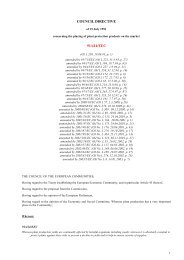
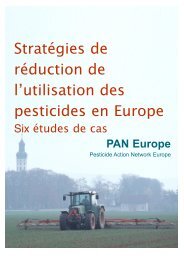
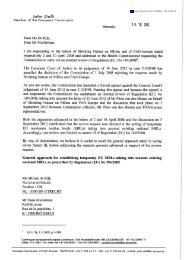
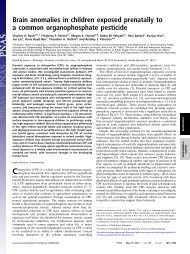
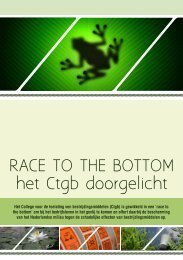
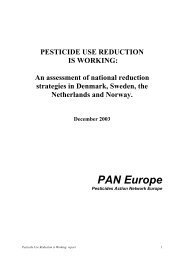
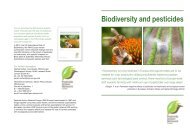
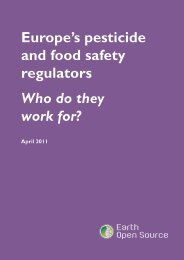
![Complete article [PDF 56KB] - PAN Europe](https://img.yumpu.com/41450983/1/190x245/complete-article-pdf-56kb-pan-europe.jpg?quality=85)
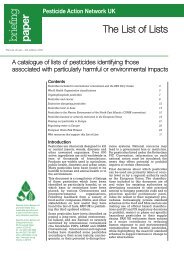

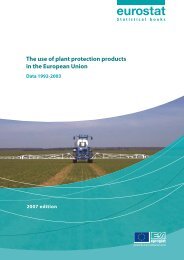
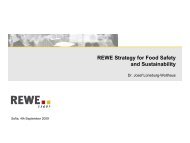
![Complete article [PDF 40KB] - PAN Europe](https://img.yumpu.com/36504990/1/184x260/complete-article-pdf-40kb-pan-europe.jpg?quality=85)